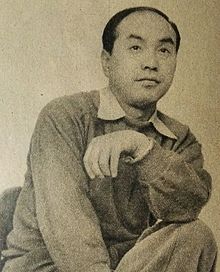Kamekura Yūsaku
Kamekura Yūsaku ( Japanese 亀 倉 雄 策 ; born April 6, 1915 in Yoshida (today: Tsubame ), Niigata Prefecture , Japan ; † May 11, 1997 in Chūō , Tokyo ) was a Japanese graphic and graphic designer specializing in commercial art and known internationally for his poster art .
life and work
Kamekura Yūsaku studied architecture and the principles of constructivism at the Institute for New Architecture and Industrial Arts ( 新 建築 工 芸 学院 , shin-kenchiku kōgei gakuin ) in Tokyo, a private institute founded by Kawakita Renshichirō with the aim of introducing design from 1935 to 1938 -Theories of the Bauhaus in Japan. Kamekura worked from 1938 for KK Nihon Kōbō (English Japan Studio ; from 1939: Kokusai Hōdō Kōgei KK ) in Tokyo.
From 1938 Kamekura was the art director of a number of Japanese magazines, including “Nippon”, and the Japanese Chamber of Commerce. In 1951 he helped found the Japan Advertising Arts Club , which was dedicated to the social recognition of the profession of graphic designer. In 1955 he took part in the "Graphic 55" exhibition, together with Hara Hiromu , Paul Rand and others.
In 1956, Kamekura received an award from the Japan Advertising Arts Club for a poster calling for the peaceful uses of nuclear power . He co-founded the Nippon Design Center in Tokyo in 1960 with Ikkō Tanaka .
Outside of Japan, his most famous designs are the posters for the 1964 Olympic Games in Tokyo and for the Expo '70 in Osaka . Exhibitions of his works took place in the Museum of Modern Art in New York City (1953) and in Chicago (1956). In 1964, his works were shown in the graphics department at documenta III in Kassel .
In 1978 he became chairman of the newly formed Japan Graphic Designers Association (JAGDA for short), which publishes richly illustrated books on the work of Japanese graphic designers every year. For his exhibition " The Universe of Curved and Straight Lines: Designs by Kamekura Yūsaku " he received the 25th Mainichi Arts Award in 1983. In the same year he was also awarded for his services to bring Japanese design to an international level with the Asahi Prize awarded.
He was one of the pioneers of Japanese graphic design who was instrumental in establishing graphic design as an essential factor in modern society, art and culture. With his work, he has contributed to the reputation of modern Japanese graphic design internationally. He designed logos , posters, books, magazines, company symbols, street signs and packaging. His work is characterized by its dynamism, the special composition of technical know-how and visual inventiveness. He used photography and colors in conjunction with geometric elements. He has been a successful teacher, lecturer and writer and has received numerous awards for his designs in Japan and internationally. His works are part of important public collections, for example in the Museum of Modern Art in New York or in the Stedelijk Museum in Amsterdam .
Literature and Sources
- documenta III. International exhibition ; Catalog: Volume 1: Painting and Sculpture; Volume 2: Hand Drawings; Volume 3: Industrial Design, Graphics; Kassel / Cologne 1964
- 東京 国立 近代 美術館 / MOMAT :特別 展 ・ 亀 倉 雄 策 の ポ ス タ ー (Japanese: Catalog for the special exhibition "Kamekura Yūsakus Plakate" 1996)
Web links
- Examples of his work
- Examples of his work
- KK Nippon Design Center Official Website (Japanese)
- Materials by and about Yusaku Kamekura in the documenta archive
Individual evidence
- ↑ a b c 亀 倉 雄 策 . In: ブ リ タ ニ カ 国際 大 百科 事 典 小 項目 事 典 at kotobank.jp. Retrieved December 3, 2014 (Japanese).
| personal data | |
|---|---|
| SURNAME | Kamekura Yūsaku |
| ALTERNATIVE NAMES | 亀 倉 雄 策 (Japanese) |
| BRIEF DESCRIPTION | Japanese graphic artist |
| DATE OF BIRTH | April 6, 1915 |
| PLACE OF BIRTH | Yoshida (now: Tsubame ), Niigata Prefecture , Japan |
| DATE OF DEATH | May 11, 1997 |
| Place of death | Tokyo |
